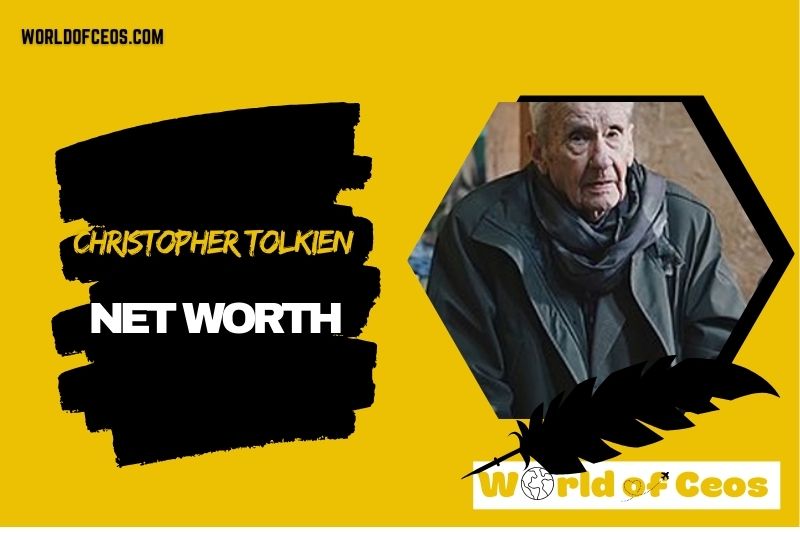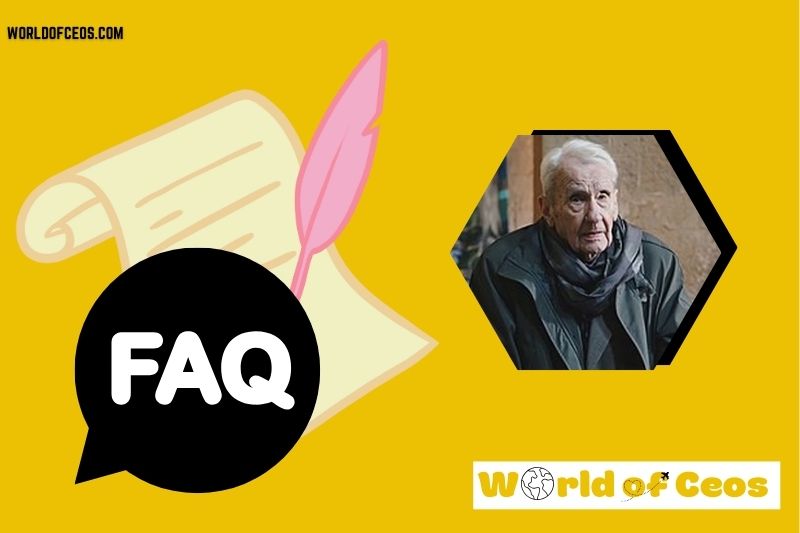Hey, WorldofCeos here! When it comes to Christopher Tolkien net worth, there’s more than just the numbers to consider. This guy didn’t just inherit a literary legacy; he built an empire around it.
By diving into his work managing and expanding J.R.R. Tolkien’s world, editing pivotal Middle-earth publications, and handling billion-dollar licensing deals, Christopher Tolkien made a lasting financial impact.
Let’s uncover how he did it, the impressive decisions that bolstered his wealth, and the challenges he faced while preserving his father’s legendary universe.
Quick Facts
| FACT | DETAIL |
|---|---|
| Real Name | Christopher John Reuel Tolkien |
| Popular Name | Christopher Tolkien |
| Gender | Male |
| Birth Date | November 21, 1924 |
| Age | 95 (Died: January 16, 2020) |
| Parents | J.R.R. Tolkien, Edith Tolkien |
| Siblings | Michael Tolkien, John Francis Reuel Tolkien, Priscilla Reuel Tolkien |
| Birthplace | Leeds, England |
| Nationality | English, naturalized French |
| Ethnicity | British |
| Education | Dragon School, The Oratory School, Trinity College, Oxford |
| Marital Status | Married (twice) |
| Spouse | Baillie Tolkien (m. 1967–2020), Faith Faulconbridge (m. 1951–1967) |
| Children | Simon Tolkien, Adam Reuel Tolkien, Rachel Clare Reuel Tolkien |
| Dating | N/A |
| Net Worth | $150 million |
| Source of Wealth | Publishing, Licensing |
| Height | N/A |
What is the Net Worth of Christopher Tolkien in 2024?

Christopher Tolkien’s net worth in 2024 is estimated to remain around $150 million. This fortune places him in the upper ranks among literary heirs and executors who’ve maximized the financial potential of a legacy.
Unlike many literary estates, the Tolkien Estate achieved exceptional success due to Christopher’s strategic negotiations, including the Amazon deal for The Lord of the Rings. Compared to other richest authors, Christopher’s wealth has notable staying power in the publishing industry. Here’s a quick look at others in this league:
- J.R.R. Tolkien
- Simon Tolkien
- Amazon Studios executives (related to licensing deals)
- Faith Lucy Tilly Tolkien
- Baillie Klass
- Guy Gavriel Kay
- Geoffrey Chaucer (historical literary peer)
- Humphrey Carpenter
- Charles Noad
- Peter Jackson
Christopher Tolkien Salary and Finance Overview

Role in Managing and Expanding His Father’s Literary Works
Taking on the responsibility of his father’s estate, Christopher Tolkien wore many hats: literary executor, editor, and even “curator” of J.R.R. Tolkien’s universe.
His efforts in publishing The Silmarillion, which was initially an unpublished manuscript, were game-changing.
The book became a foundation for Tolkien fans and was a financial win for the estate, further supported by publishing rights and consistent royalty streams.
Over the years, Christopher’s careful management contributed to a steady income, and his choices secured the Tolkien legacy for future generations.
How His Role as Literary Executor Contributed to His Financial Success
As J.R.R. Tolkien’s appointed literary executor, Christopher controlled how the world saw Middle-earth. This role didn’t just mean collecting royalties but actively managing copyrights and deciding when and how to release his father’s unpublished work.
By framing works like The History of Middle-earth and editing Unfinished Tales, he transformed Middle-earth into a comprehensive, multi-volume narrative that kept fans engaged—and brought continuous royalties.
His meticulous editing work gave the estate a unique academic allure, making Middle-earth not just a fandom but a respected literary world.
Achievements in Editing and Publishing Middle-earth Literature
Christopher’s editorial hand brought The Silmarillion, The Children of Húrin, and The History of Middle-earth series to life, transforming loose notes and drafts into iconic literature. These publications not only resonated with Tolkien enthusiasts but became enduring financial assets.
Income from these books and their continuous popularity kept Christopher’s finances robust, even as he invested time and resources in perfecting each piece. This dedication to preserving the narrative continuity and depth of Middle-earth created a high-value legacy.
Key Contributions to J.R.R. Tolkien’s Middle-earth and Literary Estate
Christopher also drew original maps for The Lord of the Rings, visually guiding readers through Middle-earth. His skills as a philologist and scholar played a huge role in presenting the works as academic masterpieces.
Through these works, Christopher Tolkien’s wealth grew alongside Middle-earth’s rising popularity, especially as new readers discovered Tolkien’s world.
Bringing The Silmarillion to Publication
Published in 1977, The Silmarillion was among the first posthumous works Christopher compiled.
Its success validated the Tolkien legacy, solidifying a strong financial foundation for the estate. This book opened doors for future works and began a lucrative publishing journey that would continue for decades.
Launching The History of Middle-earth Series and Its Financial Impact
Christopher edited The History of Middle-earth into 12 volumes, each unveiling rich details of Middle-earth’s mythology. Released between 1983 and 1996, this series became a definitive piece of Tolkien scholarship, enhancing the estate’s value.
It gave fans unprecedented insight into Tolkien’s creative mind, ensuring a consistent revenue stream and reinforcing the Tolkien name in literature.
The Impact of Licensing and Film Adaptations on His Financial Growth
Film adaptations of The Lord of the Rings and The Hobbit didn’t just popularize Middle-earth; they brought in massive licensing income.
Christopher Tolkien’s stance on adaptations was careful—he wasn’t a fan of the changes, but he understood their financial benefits.
His family eventually secured an undisclosed settlement for unpaid royalties from New Line Cinema, reinforcing the estate’s rights and finances.
Negotiating the Amazon Studios Deal for Middle-earth Rights
Christopher’s biggest financial move came with a $200 million licensing deal with Amazon Studios, setting the stage for The Lord of the Rings series adaptation.
This single agreement pushed the Tolkien Estate into a new level of financial security, ensuring Middle-earth’s relevance for a new generation.
This licensing income underpins Christopher Tolkien’s legacy, showing his talent not just as an editor but as a strategic financier of the Tolkien world.
FAQs about Christopher Tolkien

What role did he play in the Tolkien Estate?
As the literary executor of the Tolkien Estate, he managed his father’s works, overseeing all publications, film rights, and licensing deals, including negotiating with studios like Amazon.
How did he expand Middle-earth beyond books?
He facilitated new editions, collected works, and major film adaptations, with strategic partnerships and licensing deals that widened the reach of Tolkien’s legacy.
Did he face challenges in maintaining Tolkien’s literary integrity?
Yes, Christopher was initially skeptical about film adaptations and was known to challenge them, ensuring they stayed true to Tolkien’s original vision.
Which awards did he receive for his contributions?
He was awarded the Bodley Medal in 2016, recognizing his significant role in preserving and expanding J.R.R. Tolkien’s works.
What were his most notable publications?
He published The Silmarillion, The Children of Húrin, and The History of Middle-earth, among others, which are now essential readings for Tolkien fans worldwide.
How did his family influence his career?
Christopher worked closely with family members like his son Simon, who also became a writer. His family and estate trustees continue to manage Tolkien’s legacy.
Was he ever involved in legal disputes over Tolkien’s works?
Yes, Christopher led a case against New Line Cinema for unpaid royalties from the Lord of the Rings films, resulting in a successful settlement.
Did he ever collaborate with other authors?
He collaborated with Guy Gavriel Kay in the editing of The Silmarillion, ensuring it reached its final form as a complete narrative.
What made him a unique literary executor?
He balanced scholarly dedication with financial savvy, preserving Middle-earth’s academic integrity while securing lucrative licensing agreements for the Tolkien Estate.
Conclusion
Want to know more about the lives and legacies of iconic figures? Dive deeper into celebrity finances on worldofceos, and don’t forget to leave a comment or share your thoughts!

